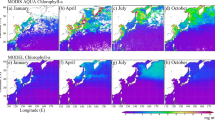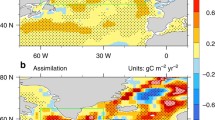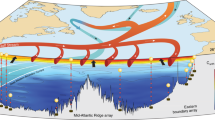Abstract
The ocean takes up a large fraction of the Pertubation CO2 that enters the atmosphere by human activity. A realistic representation of this uptake in numerical models is essential for future climate studies. Uptake of CO2 or other atmospheric trace gases is strongly influenced by oceanic physical variability at spatial scales between 20 and 100 km. Our main goal is to study the effect of this mesoscale variability on the cumulative uptake of anthropogenic CO2 and chloroflu- orocarbons using an existing model of the ocean circulation in the Atlantic that resolves a significant part of that variability explicitly because of its grid spacing of about 20 km. Results are compared with simulated trace gas distribution obtained from a model with coarser resolution.
Access this chapter
Tax calculation will be finalised at checkout
Purchases are for personal use only
Preview
Unable to display preview. Download preview PDF.
Similar content being viewed by others
References
A. Beckmann and R. Döscher. A method for improved representation of dense water spreading over topography in geopotential-coordinate models. J. Phys. Oceanogr., 27:581–591, 1997.
M. D. Cox. Isopycnal diffusion in a z-coordinate model. Ocean Modelling, 74:1–5, 1987. unpubl. manuscr.
L. Czeschel. Modelluntersuchungen zur Ventilation der Hauptsprungschicht im subtropischen Nordatlantik. Master’s thesis, Institut für Meereskunde an der Universität Kiel, 2000.
M.H. England and E. Maier-Reimer. Using chemical tracers to assess ocean models. Rev. Geophys., 39:29–70, 2001.
A. Körtzinger, M. Rhein, and L. Mintrop. Anthropogenic CO2 and CFCs in the North Atlantic ocean-a comparison of man-made tracers. Geophys. Res. Lett, 26:2065–2068, 1999.
P. Müller and J. Willebrand. Equations for oceanic motions. In Landolt-Bömstein, Group V, Oceanography, Volume 3b, pages 1–14. J. Sündermann, Ed., Springer Verlag, Berlin, 1989.
J.C. Orr, E. Maier-Reimer, U. Mikolajewicz, P. Monfray, J.L. Sarmiento, J.R. Toggweiler, N.K. Taylor, J. Palmer, N. Gruber, CL. Sabine, C. Le Quéré, R.M. Key, and J. Boutin. Estimates of anthropogenic carbon uptake from four three-dimensional global ocean models. Global Biogeochem. Cycles, 15(1):43–60, 2001.
R. C. Pacanowski. MOM 2 Documentation, User’s Guide and Reference Manual. Technical Report 3, GFDL Ocean Group, 1995.
M. H. Redi. Oceanic isopycnal mixing by coordinate rotation. J. Phys. Oceanogr., 12:1154–1158, 1982.
R. Redler, K. Ketelsen, J. Dengg, and C.W. Böning. A high-resolution numerical model for the circulation of the Atlantic ocean. In H. Lederer and Friedrich Hertweck, editors, Proceedings of the Fourth European SGI/CRAY MPP Workshop, pages 95–108. Max-Planck-Institut für Plasmaphysik, 1998.
C. Völker, J. Willebrand, and J. Dengg. Anthropogenic CO2 uptake in the Atlantic studied with a basin-scale ocean general circulation model, submitted manuscript, 2001.
Author information
Authors and Affiliations
Editor information
Editors and Affiliations
Rights and permissions
Copyright information
© 2002 Springer-Verlag Berlin Heidelberg
About this paper
Cite this paper
Redler, R., Beismann, JO., Czeschel, L., Völker, C., Dengg, J., Böning, C.W. (2002). Hindcasting the Uptake of Anthropogenic Trace Gases with an Eddy-Permitting Model of the Atlantic Ocean. In: Krause, E., Jäger, W. (eds) High Performance Computing in Science and Engineering ’01. Springer, Berlin, Heidelberg. https://doi.org/10.1007/978-3-642-56034-7_38
Download citation
DOI: https://doi.org/10.1007/978-3-642-56034-7_38
Publisher Name: Springer, Berlin, Heidelberg
Print ISBN: 978-3-642-62719-4
Online ISBN: 978-3-642-56034-7
eBook Packages: Springer Book Archive




